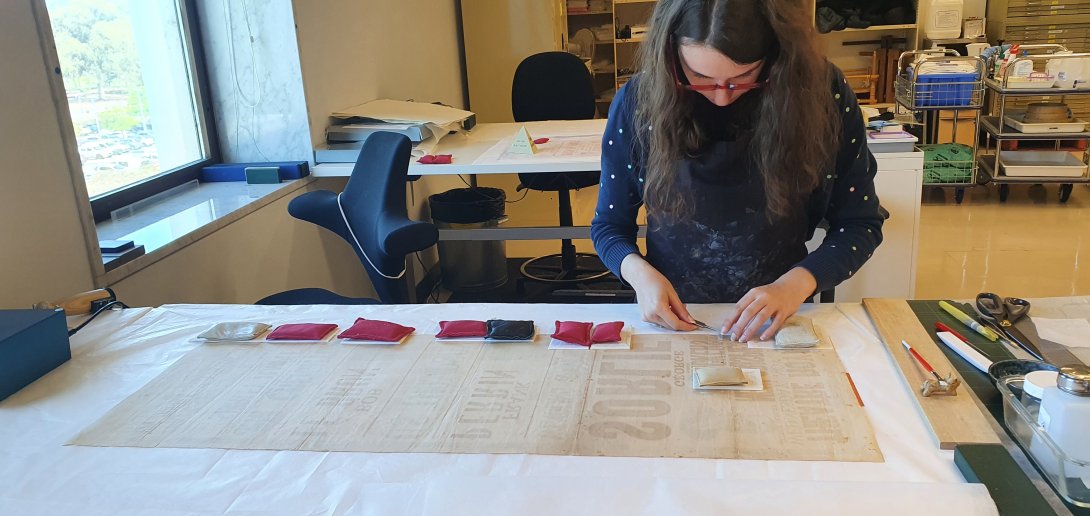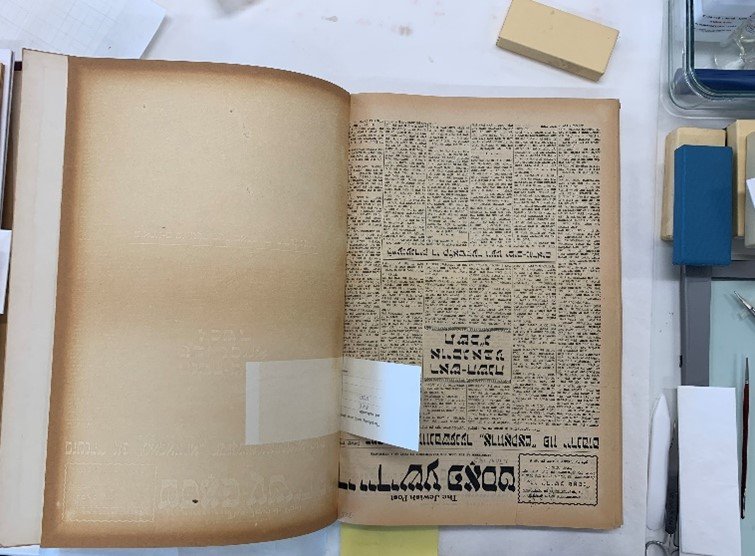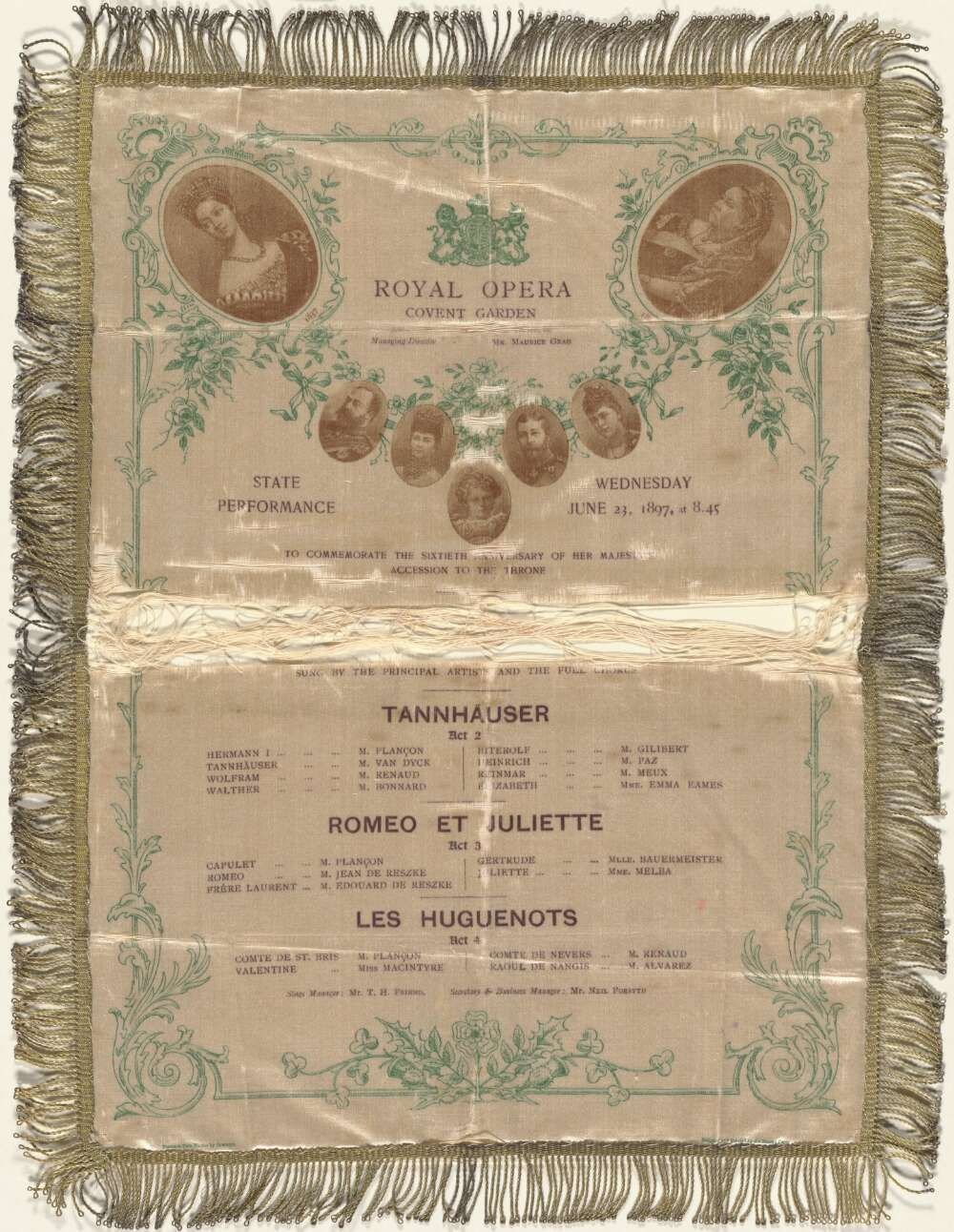
Held internationally on Friday 4 November, the ‘Ask a Conservator Day’ social media campaign acknowledges and celebrates the growing and innovative field of conservation of physical and digital materials.
This year, the National Library of Australia’s Collection Care and Digital Preservation conservators answered questions about preventive conservation throughout the day, across the Library’s Facebook, Instagram, Twitter and LinkedIn, and Trove’s Facebook and Twitter.
Here are some questions that were asked:
How do the Library’s conservators deal with dust on materials?
You can remove dust by dusting the item with a soft artist’s brush, or by puffing air over the item. Once the item is clean, store it in an enclosure, such as a plastic sleeve or archival folder, to keep future dust away.
For digital material, our conservators also suggest puffing air over the item. You can gently wipe optical discs like CDs with a damp soft cloth, being careful not to scratch the surface. These instructions can be helpful with cleaning a CD.
What’s the best way to clean 35mm negatives that have been poorly stored before I scan them for digital preservation?
With negatives in poor condition, our conservators recommend cleaning the film negatives with a very light touch such as air or a soft cloth. It’s important to note that cleaning solutions of any kind can damage the emulsion as its surface can easily scratch or solubilise the dyes.
An air puffer or a can of compressed air can blow dust off the negatives, or a very gentle wipe with a lint-free cloth will work too. Once you've cleaned and scanned the negative, you can use photo editing software to edit the digital image.
How long does it take to prepare and scan the average newspaper?
All newspapers are made from materials that are not meant to last. They're produced quickly with the information of the day and often show age, wear and tear,” Tania, Director of Collection Care, said.
“Think about any newspapers you keep and how they turn yellow and brittle over time, losing strength and getting torn easily.
You can see an example here of how much they can discolour!

Our Collection Care colleagues will often prepare fragile material before it is digitised. Conservation treatments are tailored for each item, considering the materials it is made from and the condition it is in. For newspapers, our conservators usually perform tear repairs to stabilise the material, so it is safe to handle during scanning and to reveal more information if areas are obscured. Treating a basic tear can be done quite quickly using conservation grade materials like wheat starch paste and Japanese tissue paper. However, sometimes it can take our conservators many hours if there are extensive tears or multiple pages with tears!
For scanning, the time needed can depend on several factors, including the format of the item (such as if multiple newspapers are bound in a book), how many pages there are, and the size.
What is the size of the Library’s digital collection?
As of early November 2022, the size of all of the Library’s digital collection, including copies, is just over 11 petabytes. If we stored this collection on CDs and stacked on top of one another, it would reach over 20 kilometres in height!
That’s almost three times the height of Mount Everest or twice the highest cruising altitude of an intercontinental airliner.
Much of your collections is available for public access. How do you balance the need to protect and conserve items with access and use?
As a Library, one of our main objectives is to provide access to the collections. Our collections can be accessed in multiple ways - online, in person in our Reading Rooms, as well as on display in exhibitions and loans. Our conservators look to balance access needs with an item's long-term preservation using risk management and preventive conservation techniques.
The decision-making undertaken by the Library considers the significance or priority of an item. Our Collection Care team provided the example of unique and fragile items like the recently digitised Dame Nellie Melba's silk programs or the Library’s items on the UNESCO Memory of the World Program. The approaches to preservation and access for objects such as these is a more delicate balance due to their invaluable heritage to Australia and the world. This in contrast to recently printed books where multiple copies exist.
Access to fragile items is enhanced by their digitisation. This means images of the item can be accessed while the item itself stays in archival storage. Digitised images can also be zoomed in on which is not possible with the original. The Library continues to care for our collection to enable access today and into the future!

What kinds of material are hard or challenging to treat and might provide conservators with a bit more difficulty?
Our conservators never know what is going to come across their bench.
“Even when you’ve treated a similar item hundreds of times before, all it takes is for the item to have a different history or be made from slightly different materials and it can react completely differently,” Tania, Director of Collection Care, said.
“We’re always on our toes, and make sure to assess items individually and cater the treatment to that item. Sometimes the item is something we’ve never seen before and it requires us to do research, analysis or contact specialists from other fields so we can collaborate on the right treatment approach”.
Our Digital Preservation team often encounter complex digital formats which are made up of many different parts that interact with each other in a sophisticated way. An example of such complex formats is Geographic Information Systems data which can be used for a variety of purposes including in mapping programs. These complex objects require preservation not only of the items themselves, but also the meaning of the data, and of the knowledge of how to work with it.
Learn more about preserving our digital preservation.
Is it still a good idea to place paper documents into archival plastic sheaths?
Archival plastic sleeves are a good way to store documents and photographs as it allows you to see the information on the document without removing it from the sleeve. Sleeves made from polyester, polyethylene and polypropylene are stable and will not harm items, while our conservators avoid sleeves made from PVC.
What can you do to stop the spread of rust on both paper and vellum?
Iron staples corrode faster with moisture and higher temperatures. Generally, our conservators keep collections of both paper and vellum cool, dry, clean, and out of direct sunlight. While staples can be removed to limit or prevent staining, it is worth checking whether the staples are part of the original object and if they’re serving their intended purpose of holding the material together. Iron staples, if removed, can be replaced with sewing, plastic paperclips, stainless steel or copper staples.
How do you clean an item such as the 19th Century French Atlas that the Library holds in its collection?
The Library’s Collection Care team are primarily book and paper conservators.
With the 19th century French Atlas, which is held by the Library, a soft bristle brush was used to clean small particles of loose dust and dirt from the gutter (the bottom of the ‘V’ between pages), the page surface and the cover. Often, this is the only cleaning needed. Other times there may be staining, adhesive, or mould that, if appropriate, are cleaned with conservation tools and chemicals. Simple treatments are often the best and least intrusive for an object.
The Atlas is held in a controlled storage environment and housed in an archival acid-free box for protection.

What is the most used cleaning "tool" when preparing items for Trove?
When preparing items for digitisation and inclusion in Trove, they're not always cleaned. If the information is readable, our Collection Care and Digitisation teams will instead make sure their hands, tables and equipment are all clean to limit any transfer of dirt.
There are many tools that may be used when preserving material for digitisation, such as a soft, wide artist’s brush to gently remove surface dust, or our favourite, the septum elevator While usually used for nose surgery, this tool has lovely, tapered ends which can help precisely lift, move and access parts of an item during a conservation treatment. The Library’s approach is only to do interventive treatments when necessary.

Learn about the digitisation of the Library’s collections.